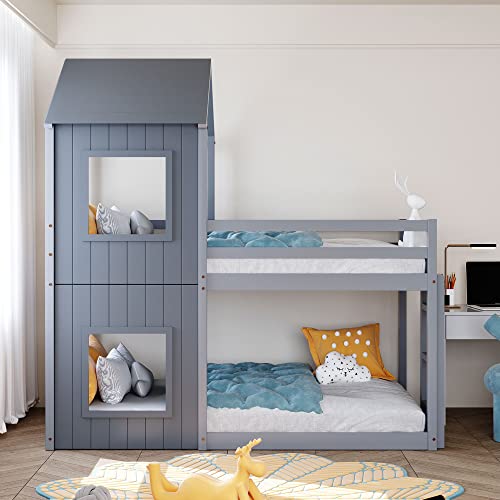Are Kids Ready For Bunk Beds?
Bunk beds can be a great solution for kids’ rooms. They can also double as a study or playroom space during the daytime.
You’ll need to assess your child’s ability to dexterity and maturity when they are ready to move into a bunk bed. Also, you must take into consideration their sleeping habits.
Age of Transition to the Top Bunk
The age at when children are ready for bunkbeds can vary greatly. The majority of experts advise that children do not sleep on the top bunk until they turn six years old. This is because children under six years old are more likely to lack the dexterity and maturity needed to safely navigate the ladder. They may also have difficulty understanding and adhering to safety guidelines for example, not climbing on the guardrails or jumping from the top bed.
It’s also important to consider the level of raunchy your child is when determining if they are ready to sleep in bunk beds. Children who are rough or disobey the rules should not use bunk beds as they could result in serious accidents. Children who are more likely to fall out of the bed or are taller than average might not be able to use the top bunk in a safe manner even if they’re six years old.
As children grow older and their bunk beds be too small. In this scenario it’s a good idea to move them to a more traditional bed so they can sleep more comfortably and with more space. It can be as simple as switching to twin beds or as complicated as investing in a great treehouse-style bunk bed such as the Mathy by Bols that can convert into a full size bed.
When it comes to making this transition, you should begin with the lowest bunk and then work to the upper levels. By doing this, you will be sure that your child is emotionally and physically ready for the transition. This will help them not get discouraged if the chance to move to the top bunk isn’t presented to them immediately.
It’s also an excellent idea for parents to teach their children the importance of following safety rules, regardless of where they sleep on the bed. This includes teaching children not to jump off the bunk, to not hang items from the rails and to use the ladder correctly.
Safety Considerations
Bunk beds can be a fantastic option for children, but you should be aware of the safety dangers. Understanding the risks, following the instructions for assembly provided by the manufacturer, and implementing other precautions can ensure that your children have fun playing with bunk beds without risk.
One of the biggest dangers to safety is the ladder, which could be used to climb to or from the top bunk. Unsupervised, children may use the ladder to play, which could have dangers. Ladders that are improperly secured may fall off the edge of the bunk bed, pinning children underneath and potentially result in fatal head injuries. Children could also slip on the ladder and lose their balance when trying to climb, resulting in falling.
To decrease the risk, educate your child to make use of the stepladder for climbing up and down the ladder, and not as a toy. A night light or other form of lighting close to the ladder is a good idea. This will help illuminate the way up and down the ladder in the dark and stop children from accidentally falling off or slipping over the furniture or other items in the room, such as furniture or toys.
Other safety concerns include making sure that the mattress is the correct size for the frame of the bunk bed, positioning the bed away from blinds (especially cords) windows, ceiling fans, and making sure there aren’t sharp corners on the bunks or near the edges of the ladder. It is also important to prevent rough play and horseplay on the bunks as this can lead to structural damage and injuries.
Before letting your children get into their bunks make sure you give them an inspection thoroughly to make sure there are no loose screws or weak points, or any other danger places. Also make sure there are no gaps or gaps in the safety railing or the headboard that could let a child’s head or limbs to become wedged in. These gaps should not be larger than 3.5 inch. As per safety guidelines, you must also make sure that the guardrails on either side of the top bunk are at least 5 inches over the mattress.
How to Choose the Right Bunk Bed
There are many options for bunk beds that can create a social and fun room for children. You can make the most of space and accommodate a variety of sleep needs and preferences by choosing the right bunk layout for your bed.
To help you navigate the bunk bed selection process begin by looking through the wide range of materials and finishes to find the ideal bed for your children’s bedroom design. Consider the style of the headboards and feetboards as well the type of slats you prefer or solid panels, or curved bed ends. Pick a hue that is in harmony with the interior of your home and can endure the test of changes and time.
Then, decide if you want the bunk beds to have the option of a ladder, an angled ladder or staircase, all of which offer unique safety benefits and advantages as well as conveniences. Ladders, especially angled ones, can take up less floor space, but are harder for younger children to climb. Staircases require more assembly time and could be costly.
Standard bunk beds consist of two twin beds perpendicular to each other that are stacked on top of one other with an elevator or ladder to access the top. Alternatively, look into a loft bed which offers open space underneath for storage, a desk or play area. These types of beds can also accommodate a full mattress on the bottom and a twin on the top, providing flexibility in the dozing options for children’ shared bedrooms or holiday homes.
After you’ve determined the kind of bunk bed that’s ideal for your family It’s time to start shopping. Check out the options at furniture stores or home improvement centers as well as online retailers to find a bunk bed that will meet the needs of your children.
When you are choosing a bunk bed, pay special attention to the material of the frame, as it plays a crucial part in your child’s security and comfort. Avoid inexpensive, low-quality materials that can easily fall apart or even break. Solid woods are better than particle boards, which are made of smaller wood flakes that have been joined. They are more durable and stable.
Getting Started
Most kids will eventually fall in love with the idea of bunk beds. They are the perfect solution to rivalry between siblings over who gets to sleep in the top bunk and it’s a great way to accommodate more than one child in a small space. Bunks are a great way to make room for friends at sleepovers and have fun without having to buy additional bedding.
If you are deciding on the best bunk bed for your family, there are crucial things to think about. Firstly, consider whether your kids can get into and out of the top bunk comfortably and safely. This is particularly crucial for children who are prone to sleepwalking or those who are prone to rolling off the sides of the bed. If they can’t do this easily, then a ladder might be the best option.
Another important consideration is the overall look and design of the bunk bed’s design and style. You should make sure that it is suitable for the interior of your home and that your children enjoy it. Bunks are available in a variety of styles from traditional to modern. They can be made of different materials like pine or MDF based on your personal preferences.
It is a good practice to create an inventory of the tools you’ll need prior to assembling your bunk beds . This will prevent any frustrations like discovering that you’ve misplaced a screw halfway through the work.
Being creative with your bunk bed can add to its appeal for your kids. There are a myriad of fun add-ons to choose from. For instance themed bed tents can transform the top bunk into a fort or castle. Your children will be thrilled to play in the bunk all day and night. ).
You will have to encourage your children to put their toys away after playing. A bunk bed with built-in storage is a good option, as it will allow you to keep your kids’ bedrooms clean and tidy while giving them access to their favorite books and toys.
Business Hours
| Open | Close | ||
|---|---|---|---|
| Monday | Open (24 Hours) | ||
| Tuesday | Open (24 Hours) | ||
| Wednesday | Open (24 Hours) | ||
| Thursday | Open (24 Hours) | ||
| Friday | Open Today (24 Hours) | ||
| Saturday | Open (24 Hours) | ||
| Sunday | Open (24 Hours) | ||


Leave feedback about this